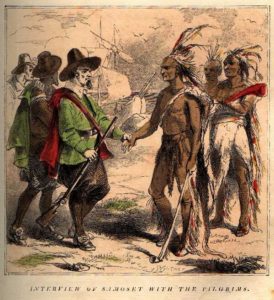The first native to greet the pilgrims was an Abenaki sagamore named Samoset. He shocked the Pilgrims when he arrived at their village and began speaking English with them. He had acquired the language from an English fisherman in modern-day Maine.

Samoset finds a place in American History books through unbelievable timing. He was not from the area and was visiting Chief Massasoit at the time the Pilgrims arrived. We know very little about him after he left the area and returned to his tribe.
Samoset Facts: Life and Legacy
- Samoset was a sagamore (subordinate chief) of an Eastern Abenaki tribe that resided at that time in what now is Maine. An English fishing camp had been established to harvest from the bountiful area now called the Gulf of Maine.
- Samoset learned some English from fishermen who came to fish off Monhegan Island, and he knew most ship captains by name. The Abenaki language is an Algonquian language related to the Massachusett language of the Nauset and Wampanoag people of the area around Plymouth Colony.
- Samoset was visiting the Wampanoag chieftain Massasoit at the time of the historic event. On March 16, 1621, Samoset entered the encampment at Plymouth, greeted the colonists in English, and asked for beer. After spending the night with the Pilgrims, he left to return with five others, who brought deer skins to trade.
- As it was Sunday, the colonists declined to trade that day but offered them some food.
- On March 22, 1621, Samoset came back with Squanto, the last remaining Patuxet tribesman, who spoke much better English than he.
- Squanto arranged a meeting with Massasoit. In 1624, English Captain Christopher Levett entertained Samoset and other Native American leaders in the harbor of present-day Portland, Maine.
- Samoset is believed to have died around 1653 in what today is Bristol, Maine.
